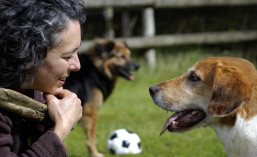Ask ten dog trainers to name the most essential behavior a dog should learn and nine of the ten are likely to answer, “a reliable recall.” Coming when called — dependably, despite distractions — saves dogs’ lives and owners’ sanity. Dogs who master this skill lead fuller and freer lives too, because they have the privilege of being off-leash on occasions when it is safe and where it is legal.
What exactly is a reliable recall? It’s when you call your dog once and she immediately begins running straight toward you as fast as she can, and then stops within touching distance. Sitting in front of you isn’t necessary, but it is important that your dog be close enough for you to hold her collar or harness so you can attach a leash.
If You Build It, They Will Come
Fabulous, fluent recalls are created like any other behavior: they are established gradually, one reinforced repetition at a time. With my clients’ dogs and with my own, my goal is to brainwash them thoroughly into believing that “Come!” or “Here,” or any word used consistently as a recall cue means, “I’m having a party, right here and now, with food and fun and surprises.” I want to create a powerful dog magnet.
The secret of reliable recalls (RR) is easy to remember: reinforced repetitions (RR). Fifty daily repetitions, spread throughout the day, should take less than 15 minutes and will build a durable habit.
How to Begin
If your dog’s response to your current recall cue is indifference or ambivalence, pick a new cue word (I use “Here!”) and start training from scratch. It’s easier than rehabilitating an old cue, especially if that one has been occasionally paired with punishment or has been shouted repeatedly with no consequence.
Use this new cue word with great care. Initially, say it only when you are sure your dog will respond correctly by moving immediately toward you. Use it not as a command but as a prediction. So “Spot Here!” means, “I would bet someone $100 that Spot will move toward me within the next few seconds.” Good instances to say your cue are when your dog is already moving toward you (trainers call this procedure “capturing” a behavior) or when you’re sure there are no interesting smells or sights to distract your dog.
If you wouldn’t make such a bet, don’t say the cue; instead just go fetch your dog (i.e., go up to her and gently lead her by the collar or harness). You don’t want to repeat your cue. Chanting “Here, Here! HERE!!” is not only frustrating, it’s futile training.
If you decide to try saying the cue — that is, you make the bet — and your dog doesn’t respond, you’ve lost $100. Now you have to “pay back” the loss by practicing the recall with your dog for 100 very easy, heavily rewarded repetitions.
More Tips
In addition to repetitions, here are some other steps you can take to teach your dog a reliable recall.
Consider adding a visual signal to your recall cue. One option is to extend your hand down by your side, while bringing all five fingertips together, palm facing up. This gives your dog an obvious target, something she can touch with her nose. This fingertip-targeting behavior is easy for your dog to do. And it’s simple for you to practice many times throughout the day. Once your dog readily moves short distances to touch your fingers, you’ll have a head start on teaching the recall behavior. After all, a recall is nothing more than a long-distance targeting behavior.
Be outrageously generous with rewards. Training the recall is no time to be stingy! Use meat-based treats, a large portion of your dog’s daily kibble, a game of tug – anything your dog truly loves. Never show her the food or toy before you call her, though. Use these as reinforcements after the correct behavior, not as bribes to encourage it.
If your dog can predict what reward you have up your sleeve, she can also calculate when it’s in her best interest to ignore your recall cue. So make a point of being variable with your rewards. Give her a pat on her side for a correct response sometimes, and a huge handful of chicken for a good recall at other times. Once or twice a year, while walking with my own off-leash dogs on wooded trails, I reward their speedy recalls with an entire hamburger I’ve hidden beforehand in the crotch of a tree. This bounty surprises and thrills them, and makes their recalls even more reliable in the future.
Even with consistent practice and careful avoidance of any distractions beyond your dog’s current level of fluency, your dog will make mistakes. Don’t let that discourage you. A perfect recall is unrealistic. But a near perfect one—a reliable recall—is attainable, with persistent training and a consistent cue.
